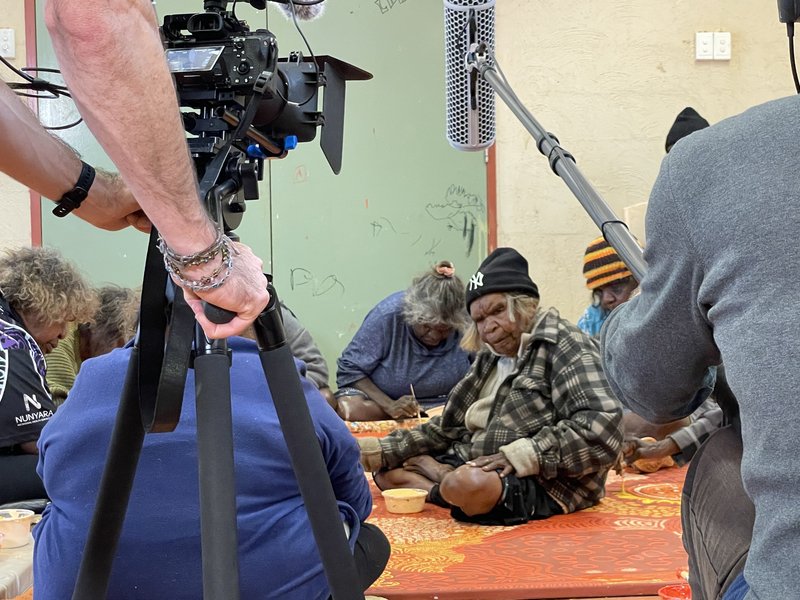Code of Practice drafting underway, plus opportunities for writers
Progress update, overview of recent consultations, and upcoming opportunities to contribute to the Code revision.
Progress update, overview of recent consultations, and upcoming opportunities to contribute to the Code revision.

Tatali Napurrula and senior women of Papunya Tula Artists in their Kintore - Walungurru studio working on a collaborative piece; filming for Desart Art Centres on Screen 2021 project. Photo by Desart.
With public consultations winding up and over twenty writers currently in the process of drafting new content, NAVA is focused on commissioning a final group of writers to draft a small number of remaining chapters over May.
In coming weeks NAVA will commence a thorough review of the drafts, including reviews from Accessible Arts, Terri Janke Company, and Arts Law, as well as a full copy edit.
NAVA aims to complete the majority of the Code revision and publically launch the new iteration by August 2022, allowing time for the sector to consider the changes ahead of the next national multi-year funding round. From there the Code will be a living document that will continue to evolve and change as our knowledge grows.
NAVA is seeking writers to contribute to the outstanding draft sections of the new Code. If you are interested in drafting new content on any of the following chapters, please visit the EOIs page for more information.
Principles, Ethics and Rights
- Care
- Community Engagement
- Emergency Response and Disaster Preparedness
- Grievance and Dispute Resolution
Exhibiting
- Exhibiting in Public Galleries
- Loaning of existing work
- Touring of existing work
- Hiring a Public Gallery Space
- Exhibition Royalties for Works in Collections
Selling and Marketing
- Art Fairs
Commissioning and Funding
- Commercial Commissions
- Private Commissions
- Temporary Public Art
Artist Self Organisation
- Art Trails
Awards, Prizes and Competitions
Equity and Equal Opportunity, March 2022
In mid-March, NAVA facilitated a consultation session with a small group of eight independent artists, curators and arts workers to work through a series of questions in relation to Equity and Equal Opportunity within the visual arts sector. The intention of this consultation was to gather feedback from the lived experience of the participating practitioners, and help inform key recommendations for good practice within the Code draft.
The consultation was wide-ranging and included discussion on:
Aboriginal Art Centres, April 2022
In collaboration with Terri Janke Company, NAVA coordinated a consultation session in mid-April with five Peak Bodies representing Aboriginal Art Centres across the nation. Participating in the session were AACHWA, Desart, IACA, UMI Arts, KU Arts and representatives from key service organisations working closely with Art Centres including Arts Law, Copyright Agency, Indigenous Art Code and the Australia Council. The consultation, facilitated by Terri Janke, aimed to share information and perspectives on the challenges that Art Centres face in collaborations and to provide useful recommendations to those seeking to collaborate with Art Centres in the future.
Throughout March and April, NAVA also carried out direct consultation with nine Art Centres across the main artmaking regions of the nation. Participating Art Centres contributed their feedback via survey and phone call focusing on what is key to developing strong and beneficial collaborations, where the key challenges or limitations lie and what the Code could contribute to help provide guidance and support.
Feedback from both consultations have now been provided to the commissioned writer of this new Working With Art Centres chapter, with a draft expected to be ready in June for further review and consultation.
The consultation feedback covered a variety of topics including:
Disability Focus Group, May 2022
The Disability Focus Group met at the beginning of May. The meeting was again facilitated by Canberra based artist and disability activist Daniel Savage and included five artists and arts workers with disability. The group discussed a draft version of the Code chapter on Accessibility. The meeting included discussion on:
You can find more information about the Code of Practice revision project and the current Code of Practice on the NAVA website. To access the Code of Practice you will need a free login to the NAVA website using an email address and password.